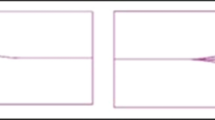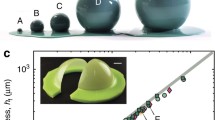Abstract
Corrugations offer a convenient way to make thin, lightweight sheets into stiff structures. However, traditional, v-shaped corrugations made from straight creases result in highly anisotropic stiffness which leads to undesirable flexibility in some directions of loading. In this paper, we explore the bending stiffness of curved-crease corrugations with a planar midsurface—developable corrugations made by folding thin sheets about curves and without linerboard covers on the top or bottom. The curved-crease corrugations break symmetry in the pattern and can redistribute stiffness to resist bending deformations in multiple directions. To study these systems, we formulate a framework for predicting the bending stiffness of any planar-midsurface corrugation from its multiple geometric features at different scales. We use the framework to create two predictive methods that provide valuable insight into the global stiffness of corrugations without a detailed analysis. Results from these methods match well with experimental, three-point bending tests of five corrugation geometries made from polyester film. We found that corrugations with elliptical or parabolic curved-creases that intersect with one edge of the pattern are best at redistributing stiffness in multiple directions. While a straight-crease pattern has a stiffness of about 4 N/mm in one direction and about 0 N/mm in the other, a parabolic crease pattern has a stiffness of about 2.5 N/mm in both directions. These curved-crease corrugations can enable the self-assembly and fabrication of practical, stiff structures from simple, developable sheets.









Similar content being viewed by others
References
Badger JC, Nelson TG, Lang RJ, Halverson DM, Howell LL (2019) Normalized coordinate equations and an energy method for predicting natural curved-fold configurations. J Appl Mech. doi 10(1115/1):4043285
Bouaziz O (2013) Geometrically induced strain hardening. Scr Mater 68(1):28–30. https://doi.org/10.1016/j.scriptamat.2012.08.008
Dayyani I, Shaw AD, Saavedra Flores EI, Friswell MI (2015) The mechanics of composite corrugated structures: a review with applications in morphing aircraft. Compos Struct 133:358–380. https://doi.org/10.1016/j.compstruct.2015.07.099
Demaine ED, Demaine ML, Koschitz D, Tachi T (2011) Curved crease folding—a review on art, design and mathematics. In: Proceedings of the IABSE-IASS symposium: taller, longer, lighter
Duncan JP, Duncan JL (1982) Folded developables. Proc R Soc Lond Ser A Math Phys Sci 383(1784):191–205
Filipov ET, Liu K, Tachi T, Schenk M, Paulino GH (2017) Bar and hinge models for scalable analysis of origami. Int J Solids Struct 124:26–45. https://doi.org/10.1016/j.ijsolstr.2017.05.028
Filipov ET, Tachi T, Paulino GH (2015) Origami tubes assembled into stiff, yet reconfigurable structures and metamaterials. Proc Natl Acad Sci USA 112(40):12321–12326. https://doi.org/10.1073/pnas.1509465112
Fraser M, Zurob HS, Wu P (2018) Comparing the effect of geometry on the stress–strain response of isolated corrugation structures and corrugation reinforced composite structures. Compos Struct 187:308–315. https://doi.org/10.1016/j.compstruct.2017.12.076
Gattas JM, Lv W, Chen Y (2017) Rigid-foldable tubular arches. Eng Struct 145:246–253. https://doi.org/10.1016/j.engstruct.2017.04.037
Gattas JM, You Z (2015) The behaviour of curved-crease foldcores under low-velocity impact loads. Int J Solids Struct 53:80–91. https://doi.org/10.1016/j.ijsolstr.2014.10.019
Gholamhoseini A, Khanlou A, MacRae G, Hicks S, Scott A, Clifton C (2018) Short-term behaviour of reinforced and steel fibre-reinforced concrete composite slabs with steel decking under negative bending moment. Adv Struct Eng 21(9):1288–1301. https://doi.org/10.1177/1369433217739710
Gilewski W, Pełczyński J, Stawarz P (2014) A comparative study of origami inspired folded plates. Proc Eng 91:220–225. https://doi.org/10.1016/j.proeng.2014.12.050
Gracias DH, Kavthekar V, Love JC, Paul KE, Whitesides GM (2002) Fabrication of micrometer-scale, patterned polyhedra by self-assembly. Adv Mater 14(3):235–238
Huffman DA (1976) Curvature and creases: a primer on paper. IEEE Trans Comput C–25(10):1010–1019. https://doi.org/10.1109/TC.1976.1674542
Ketchum MS (1955) Design and construction of a folded plate roof structure. ACI J Proc 51(1):449–456. https://doi.org/10.14359/11688
Klett Y, Middendorf P, Sobek W, Haase W, Heidingsfeld M (2017) Potential of origami-based shell elements as next-generation envelope components. In: 2017 IEEE international conference on advanced intelligent mechatronics (AIM), pp 916–920. https://doi.org/10.1109/AIM.2017.8014135
Klett Y, Zeger C, Middendorf P (2017) Experimental characterization of pressure loss caused by flow through foldcore sandwich structures. In: American society of mechanical engineers digital collection. https://doi.org/10.1115/DETC2017-67890
Lang RJ, Nelson TG, Magleby SP, Howell LL (2017) Kinematics and discretization of curved-fold mechanisms. In: Proceedings of the ASME 2017. ASME. https://doi.org/10.1115/DETC2017-67439
Lechenault F, Thiria B, Adda-Bedia M (2014) Mechanical response of a creased sheet. Phys Rev Letters 112(24):244301. https://doi.org/10.1103/PhysRevLett.112.244301
Lee TU, You Z, Gattas JM (2018) Elastica surface generation of curved-crease origami. Int J Solids Struct 136–137:13–27. https://doi.org/10.1016/j.ijsolstr.2017.11.029
Liu K, Paulino GH (2017) Nonlinear mechanics of non-rigid origami: an efficient computational approach. Proc R Soc A Math Phys Eng Sci 473(2206):20170348. https://doi.org/10.1098/rspa.2017.0348
Mahadevan L, Rica S (2005) Self-organized origami. Science 307(5716):1740–1740
Norman AD, Seffen KA, Guest SD (2008) Multistable corrugated shells. Proc R Soc A Math Phys Eng Sci 464(2095):1653–1672. https://doi.org/10.1098/rspa.2007.0216
Norman AD, Seffen KA, Guest SD (2009) Morphing of curved corrugated shells. Int J Solids Struct 46(7):1624–1633. https://doi.org/10.1016/j.ijsolstr.2008.12.009
Schenk M, Guest SD (2011) Origami folding: a structural engineering approach. In: Wang-Iverson P, Lang RJ, Yim M (eds) Origami 5: fifth international meeting of origami science, mathematics, and education, 1st edn. CRC Press, Boca Raton, pp 291–303
Seong DY, Jung CG, Yang DY, Moon KJ, Ahn DG (2010) Quasi-isotropic bending responses of metallic sandwich plates with bi-directionally corrugated cores. Mater Des 31(6):2804–2812. https://doi.org/10.1016/j.matdes.2010.01.009
Thill C, Etches JA, Bond IP, Potter KD, Weaver PM (2010) Composite corrugated structures for morphing wing skin applications. Smart Mater Struct 19(12):124009. https://doi.org/10.1088/0964-1726/19/12/124009
Timoshenko S, Woinowsky-Krieger S (1959) Theory of plates and shells, 2nd edn. McGraw-Hill, New York
Vergauwen A, Laet LD, Temmerman ND (2017) Computational modelling methods for pliable structures based on curved-line folding. Comput Aided Des 83:51–63. https://doi.org/10.1016/j.cad.2016.10.002
Woodruff SR, Filipov ET (2018) Structural analysis of curved folded deployables. In: Earth and space 2018, pp 793–803. ASCE. https://doi.org/10.1061/9780784481899.075
Woodruff SR, Filipov ET (2020) A bar and hinge model formulation for structural analysis of curved-crease origami (submitted)
Zhang Z, Qiu T, Song R, Sun Y (2014) Nonlinear finite element analysis of the fluted corrugated sheet in the corrugated cardboard. Adv Mater Sci Eng 2014:654012. https://doi.org/10.1155/2014/654012
Acknowledgements
We thank Jack Riley (University of Michigan) for his preliminary experimental work on curved parabolas that verified their unique characteristics and fueled our curiosity for curved-crease corrugations, as a whole.
Funding
The authors thank the Office of Naval Research for their financial support (Grant No. N00014-18-1-2015). The first author thanks the National Science Foundation Graduate Research Fellowship Program for their support (Grant No. DGE 1256260).
Author information
Authors and Affiliations
Corresponding author
Ethics declarations
Conflict of interest
The authors declare that they have no conflict of interest.
Additional information
Publisher's Note
Springer Nature remains neutral with regard to jurisdictional claims in published maps and institutional affiliations.
In honor of Professor J. N. Reddy for his 75th Birthday.
Appendix: Details on the crease pattern geometries
Appendix: Details on the crease pattern geometries
In this appendix, we give the specific functions used to generate the flat crease patterns shown in Fig. 3. We also present the values we used in the functions so that our results can be further examined or replicated. Note that for each of the five geometries, \(W = 100\) mm, \(H = 100\) mm, \(n_s = 5\), and \(i \in \{1, 2, 3, 4, 5\}\).
Straight-crease corrugation For the straight-crease corrugation, there is one input besides the constraining assumptions: \(a_i\). The function defining the \(i{{{\text {th}}}}\) curve of the crease pattern is,
where,
The functions are defined in the domain \(-W/2 \le x \le W/2\). An example crease pattern used in the analyses and experimentation is shown in Fig. 3a with corresponding parameter values in Table 1.
Parabolic-point corrugation For the parabolic-point corrugation, there are two inputs besides the constraining assumptions: \(b_i\) and \(c_i\). The function defining the \(i{{{\text {th}}}}\) curve is,
where,
The functions are defined in the domain \(-r_i \le x_i \le r_i\), where \(r_i = \sqrt{-c_i/b_i} = W/2\). An example crease pattern is shown in Fig. 3b with corresponding values in Table 2.
Parabolic-edge corrugation For the parabolic-edge corrugation, two inputs additional inputs are required: \(b_i\) and \(c_i\). The function defining the \(i{{{\text {th}}}}\) curve is,
where,
Each curve is defined in the domain \(-r_i \le x \le\, r_i\), where \(r_i = \sqrt{-c_i/b_i} = \sqrt{W^2 i/(4n_s)}\). An example crease pattern is shown in Fig. 3c with corresponding values in Table 3.
Elliptical-point corrugation For the elliptical-point corrugation, three inputs besides the constraining assumptions are required: \(d_i\), \(e_i\), and \(f_i\). The function defining the \(i{{{\text {th}}}}\) curve is,
where,
Each curve is defined in the domain \(-r_i \le x_i \le r_i\), where \(r_i = d_i\sqrt{1-(-f_i/e_i)^2} = W/2\). An example crease pattern is shown in Fig. 3d with corresponding values in Table 4.
Elliptical-edge corrugation For the elliptical-edge corrugation, three inputs are required besides the constraining assumptions: \(d_i\), \(e_i\), and \(f_i\). The function defining the \(i{{{\text {th}}}}\) curve is,
where,
Each curve is defined in the domain \(-r_i \le x_i \le r_i\), where \(r_i = d_i\sqrt{1-(-f_i/e_i)^2} = W/2\sqrt{2i/n_s - (i/n_s)^2}\). An example crease pattern is shown in Fig. 3e with corresponding values in Table 5.
Rights and permissions
About this article
Cite this article
Woodruff, S.R., Filipov, E.T. Curved creases redistribute global bending stiffness in corrugations: theory and experimentation. Meccanica 56, 1613–1634 (2021). https://doi.org/10.1007/s11012-020-01200-7
Received:
Accepted:
Published:
Issue Date:
DOI: https://doi.org/10.1007/s11012-020-01200-7




